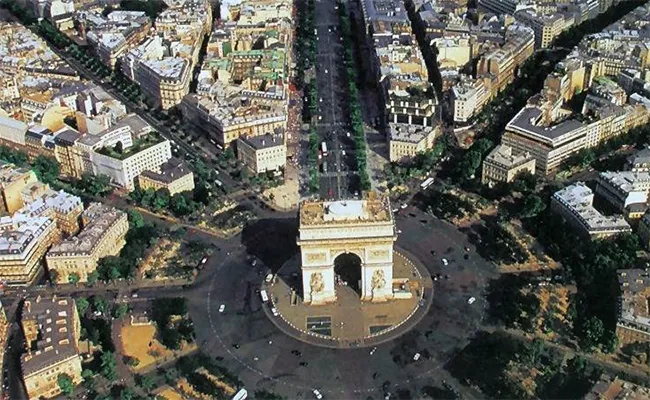Paris, the dazzling capital of France, is not only famous for its romantic beauty but also for preserving profound historical imprints. The majestic monuments in Paris are not merely magnificent architectural works but also witnesses to the ups and downs and historical events of France. Let’s explore the most important historical monuments in Paris, where the past intertwines with the present, creating a unique and captivating cultural tapestry.
Arc de Triomphe: A Timeless Symbol of Victory
The Arc de Triomphe is one of the most famous historical symbols of Paris and France. Standing majestically in Place de l’Étoile (now Place Charles de Gaulle), the Arc de Triomphe is not only a colossal architectural structure but also a symbol of patriotism and national pride.
Built to honor the military victories of Napoleon Bonaparte, the Arc de Triomphe is a testament to the might of the French Empire at that time. Construction began in 1806 and was completed in 1836, during the reign of King Louis-Philippe. With a height of nearly 50 meters, the Arc de Triomphe is one of the largest triumphal arches in the world.

The Arc de Triomphe impresses not only with its massive size but also with the intricate sculptures on its walls. Four large sculptural groups depict important historical events, the most famous of which is “The Marseillaise” by sculptor François Rude, portraying the heroic spirit of the French army during the Revolution.
Beneath the Arc de Triomphe lies the Eternal Flame, which has been burning continuously since 1923 to commemorate the unknown French soldiers who sacrificed themselves in World War I. This flame is a symbol of gratitude and respect for those who fell for their country.
Panthéon: The Resting Place of Great Minds
The Panthéon is an architectural masterpiece in the neoclassical style, located in the Latin Quarter of Paris. Originally built as a church, the Panthéon was later transformed into a final resting place for great figures who made significant contributions to France.
Inside the Panthéon, you will find the tombs of writers, scientists, philosophers, and famous historical figures such as Voltaire, Jean-Jacques Rousseau, Victor Hugo, Émile Zola, Marie Curie, and Louis Braille. Each tomb is a unique work of art, reflecting the personality and contributions of the deceased.
Visiting the Panthéon is not only a journey of architectural exploration but also a historical journey back in time, to remember and pay tribute to the great individuals who shaped France.
Notre-Dame Cathedral: Witness to History and Faith
Notre-Dame Cathedral (Cathédrale Notre-Dame de Paris) is one of the most famous Gothic architectural icons in the world. Located on Île de la Cité, the heart of Paris, Notre-Dame Cathedral is not only an important religious building but also a historical witness to the city.
Built from the 12th to the 14th centuries, Notre-Dame Cathedral has witnessed many significant historical events in France, from the coronation of kings to revolutions and wars. The characteristic Gothic architecture, with its magnificent stained glass windows, intricate sculptures, and soaring spires, creates a majestic and sublime beauty for the cathedral.
The devastating fire in 2019 caused severe damage to Notre-Dame Cathedral. However, with the efforts of the French government and people, the building is being restored and is expected to reopen in the near future.
Louvre Palace: From Fortress to Art Museum
The Louvre Palace (Musée du Louvre) is one of the largest and most famous art museums in the world. Before becoming a museum, the Louvre was a fortress built in the 12th century, later converted into a royal palace.
With a vast collection of tens of thousands of artworks from around the world, the Louvre is an unmissable destination for art and history enthusiasts. Here, you can admire masterpieces such as the Mona Lisa by Leonardo da Vinci, the Venus de Milo, and the Great Sphinx of Tanis.
Not just a museum, the Louvre is also a unique architectural work, combining classical and modern styles. The glass pyramid designed by architect Ieoh Ming Pei, built in 1989, has become a symbol of the Louvre and of Paris.
Les Invalides: Honoring Soldiers
Les Invalides (Hôtel des Invalides) is a complex of military buildings built in the 17th century, during the reign of King Louis XIV. Initially, Les Invalides was built to house soldiers wounded or disabled in war.
Today, Les Invalides is a military museum, displaying weapons, uniforms, and artifacts related to French military history. In addition, Les Invalides is also the final resting place of Napoleon Bonaparte, the famous Emperor of France. Napoleon’s tomb is located under the magnificent dome of the Saint-Louis-des-Invalides church, one of the most popular tourist attractions in Paris.
Conclusion
The historical monuments in Paris are not only beautiful architectural works but also witnesses to the ups and downs and historical events of France. Visiting these monuments is a great way to explore the culture, history, and people of Paris. Take the time to admire the beauty and understand the significance of these monuments, and you will have a memorable travel experience in the dazzling capital of France.